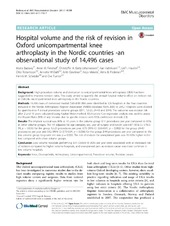| dc.contributor.author | Badawy, Mona | en_US |
| dc.contributor.author | Fenstad, Anne Marie | en_US |
| dc.contributor.author | Bartz-Johannessen, Christoffer | en_US |
| dc.contributor.author | Indrekvam, Kari | en_US |
| dc.contributor.author | Havelin, Leif Ivar | en_US |
| dc.contributor.author | Robertsson, Otto | en_US |
| dc.contributor.author | W-Dahl, Annette | en_US |
| dc.contributor.author | Eskelinen, Antti | en_US |
| dc.contributor.author | Mäkelä, Keijo | en_US |
| dc.contributor.author | Pedersen, Alma B. | en_US |
| dc.contributor.author | Schrøder, Henrik M. | en_US |
| dc.contributor.author | Furnes, Ove | en_US |
| dc.date.accessioned | 2018-08-07T13:54:03Z | |
| dc.date.available | 2018-08-07T13:54:03Z | |
| dc.date.issued | 2017-09-07 | |
| dc.Published | Badawy M, Fenstad F, Bartz-Johannessen CA, Indrekvam K, Havelin LI, Robertsson O, W-Dahl A, Eskelinen A, Mäkelä K, Pedersen AB, Schrøder HM, Furnes O. Hospital volume and the risk of revision in Oxford unicompartmental knee arthroplasty in the Nordic countries -an observational study of 14,496 cases. BMC Musculoskeletal Disorders. 2017;18:388 | eng |
| dc.identifier.issn | 1471-2474 | |
| dc.identifier.uri | https://hdl.handle.net/1956/18029 | |
| dc.description.abstract | Background High procedure volume and dedication to unicompartmental knee arthroplasty (UKA) has been suggested to improve revision rates. This study aimed to quantify the annual hospital volume effect on revision risk in Oxfordu nicompartmental knee arthroplasty in the Nordic countries. Methods: 14,496 cases of cemented medial Oxford III UKA were identified in 126 hospitals in the four countries included in the Nordic Arthroplasty Register Association (NARA) database from 2000 to 2012. Hospitals were divided by quartiles into 4 annual procedure volume groups (≤11, 12-23, 24-43 and ≥44). The outcome was revision risk after 2 and 10 years calculated using Kaplan Meier method. Multivariate Cox regression analysis was used to assess the Hazard Ratio (HR) of any revision due to specific reasons with 95% confidence intervals (CI). Results: The implant survival was 80% at 10 years in the volume group ≤11 procedures per year compared to 83% in other volume groups. The HR adjusted for age category, sex, year of surgery and nation was 0.87 (95% CI: 0.76-0.99, p = 0.036) for the group 12-23 procedures per year, 0.78 (95% CI: 0.68-0.91, p = 0.002) for the group 24-43 procedures per year and 0.82 (95% CI: 0.70-0.94, p = 0.006) for the group ≥44 procedures per year compared to the low volume group. Log-rank test was p = 0.003. The risk of revision for unexplained pain was 40-50% higher in the low compared with other volume groups. Conclusion: Low volume hospitals performing ≤11 Oxford III UKAs per year were associated with an increased risk of revision compared to higher volume hospitals, and unexplained pain as revision cause was more common in low volume hospitals. | en_US |
| dc.language.iso | eng | eng |
| dc.publisher | BioMed Central | eng |
| dc.rights | Attribution CC BY | eng |
| dc.rights.uri | http://creativecommons.org/licenses/by/4.0 | eng |
| dc.subject | Knee | eng |
| dc.subject | Osteoarthritis | eng |
| dc.subject | Arthroplasty | eng |
| dc.subject | Unicompartmental | eng |
| dc.subject | Procedure volume | eng |
| dc.subject | Revision causes | eng |
| dc.title | Hospital volume and the risk of revision in Oxford unicompartmental knee arthroplasty in the Nordic countries -an observational study of 14,496 cases | en_US |
| dc.type | Peer reviewed | |
| dc.type | Journal article | |
| dc.date.updated | 2018-03-06T13:50:39Z | |
| dc.description.version | publishedVersion | en_US |
| dc.rights.holder | Copyright 2017 The Author(s) | |
| dc.identifier.doi | https://doi.org/10.1186/s12891-017-1750-7 | |
| dc.identifier.cristin | 1511211 | |
| dc.source.journal | BMC Musculoskeletal Disorders | |

